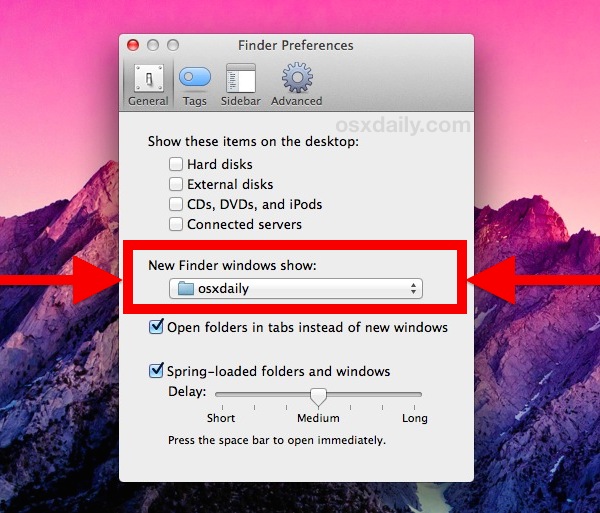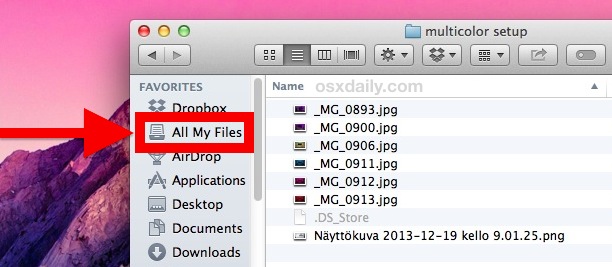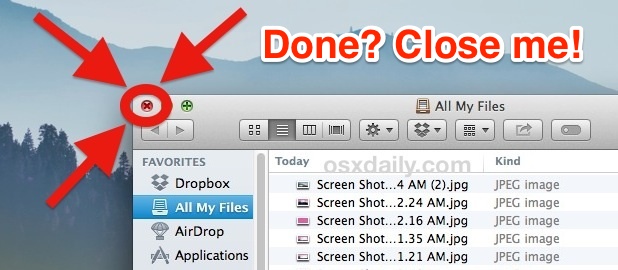Give the Mac Finder a Performance Boost by Ditching “All My Files”
![]() Though the All My Files folder is undoubtedly useful, Mac users with limited system resources along with tons of files may notice some sluggishness when using the feature. That can translate into CPU spikes and the perception of a generally slow Finder and Mac, because new windows in the file system default to opening into the “All My Files” view.
Though the All My Files folder is undoubtedly useful, Mac users with limited system resources along with tons of files may notice some sluggishness when using the feature. That can translate into CPU spikes and the perception of a generally slow Finder and Mac, because new windows in the file system default to opening into the “All My Files” view.
To better understand why the performance hit may happen, consider what All My Files is doing; it’s loading every single one of your personal files into a single smart folder, done by actively searching the file system for every document, picture, and media file that is owned by the active user account. Depending on your personal computer use, that can easily amount to 50,000+ items shown within a single folder which is updating live upon every modification of the file system. While some newer Macs with abundant system resources can do this with little impact on system performance, Macs with fewer available resources are usually he ones to notice the CPU spiking and slow refreshing of Finder windows and folders in OS X.
If you notice that opening new Finder windows is sluggish and you use All My Files, there are three fairly simple solutions to address the issue and boost Finder performance a bit.
1: Stop OS X Finder Defaulting to Opening New Windows Into “All My Files”
OS X has defaulted to opening new Finder windows into “All My Files” since the release of Lion, but from Lion through Mavericks you can easily change this and launch a new window into anything else. You can set it to the Home directory, which was the default in OS X for ages, the Desktop, or a folder of your choosing.
- From the Finder, pull down the ‘Finder’ window and choose “Finder Preferences”
- Under the “General” tab pull down the menu under “new Finder windows show:” and select the new default window destination

This speeds up the general experience of interacting with the Finder because new windows no longer have to refresh and show every single user file, instead they’ll just show what’s in the User Home directory, or elsewhere.
2: Choose To Use All My Files Selectively
Now that you don’t have the Finder opening new windows directly into All My Files, just get used to visiting it selectively, and only when it’s needed. The simplest way to do this by selecting it from the Finder window sidebar, say, when you want to get to your recently opened files:

This means you’ll only experience the (potentially) sluggish All My Files searching and redrawing when you want to, not every time you’re in the file system.
3: Close “All My Files” Windows When Finished Using Them
Regardless of when you’re using All My Files, remember to close the folder when you’re done using it. Because All My Files is not your average static folder, leaving it open causes the contents to redraw every time a user owned file is modified, copied, downloaded, or created, and that can cause CPU spikes and create substantial performance reduction if it’s just sitting there refreshing itself in the background while you go about other file system and computing activity.

The solution is so simple, use that little red button when you’re done with the folder! Don’t let it sit open in the background.
Varying Finder Performance Boosts for Old & New Macs
While new Macs may see a Finder performance boost from selectively using All My Files, this should be particularly helpful for Macs with a lot of files but fewer available resources, and used in conjunction with some other tips for speeding up older Macs you can really make a difference in how resource constrained machines perform.
It’s worth pointing out that while All My Files can cause CPU spikes when it’s being used or when it’s left open, it’s completely separate from the continuously high CPU usage problem of when the Finder process stays at 100% for no apparent reason, which is typically caused by a corrupted Finder plist file. That issue can occur on just about every Mac, usually after a system update has been installed.


Why are there duplicate files in all my files? Many of the duplicates are images that have exactly the same file name.
Why does “All my files” save everything ever opened. I have 9000+ of a lot of rubbish that I will never need. How do I get rid of it. And if I delete from “AMF” does it delete from another folder where it is saved?
Help
Yes if you delete something from “All My Files” it is deleting the file, it’s one of your files so deleting a file will delete the file. If you don’t like All My Files, don’t use it as directed in this article. Do not delete a file unless you don’t want that file.
“All my Files” doesn’t show all my files.
It appears as though the Craigslist grammar Nazi has now moved to osxdaily!
HooRay
No.
I can not get the “All My Files” to change, if I try It brings up “Other” which goes to the list DROP BOX-APPLICATIONS-DESKTOP etc
what am I doing wrong?
I find it very useful, and use it about three times a week. It is **MUCH** faster than using Spotlight to search for a recent file.
However, does anybody know a trick how to limit “all my files” to “all files opened in the last three month”?
My “all my files” shows files, which are so old that even the system forgot their exact dates. I know I should delete them all, but I do not have the time to check them and delete them one-by-one, and I do not have the guts to delete them all with one command.
You may be better off creating a unique smart folder that only contains files that have been used within the last 90 days, that way it’s self-limiting. This would be outside of All My Files, however.
I can understand why the feature can be useful for some people, but I don’t like it. I turned it off right after upgrading to Lion.
Anyone who says “all my” or “all the” or “all your” is illiterate. In these three examples, substitute “most” or “some” or “several” for “all” and the illiteracy should be become evident.
The word “of” belongs between “all” and “my” or “the” or “your.”
Congratulations! You are now eligible to pass grade school English class.
“All My Files” is the name Apple gave the feature
I know.
And what I said is still true.
DCJ001, all you wrote is out of place.
We are here discussing Mac-issues and no one needs a lecturing in language use.
Many thanks if you could refrain of it in the future!
Except it doesn’t, because it’s either an indefinite pronoun or an indefinite adjective. And guess what: it’s being used as an indefinite adjective here because “my” is a personal adjective, not a personal pronoun. So an “of” would be redundant and should be *omitted*, not prescribed.
If you’re going to try to correct someone, make sure that you yourself are correct, Einstein.
90% of the images in ‘All My Files’ are saved on an exterior hard drive. Eliminating images from AMF will not effect images on this hard drive will they?
Also, eliminating from AMF WILL effect/eliminate from Lightroom, correct?
Thank you.
I think the issue with All My Files being slow is that it does not have aggressive caching, there is seemingly no index made of the files contained in the directory, and instead it *refreshes* everything every single time it’s loaded. I thought that was the purpose of the “DS_Store” files but they do not seem to apply to All My Files due to it’s status as a “Smart” folder.
By the way, you can test out all the things that cause All My Files to spike CPU by doing this:
* Open Activity Monitor, sort by CPU
* Open All My Files
* Make duplicates of files around the Mac to watch CPU jump for Finder process
* Close All My Files, repeat the same ‘duplicate’ process – no CPU jump!
You can get an extreme example of this by opening 10 All My Files folders at once, then performing file actions like duplicates and copies. Finder may easily go to 100% CPU to 300% CPU while it goes on because it’s refreshing all these windows at once, drawing new thumbnails, refreshing all files, updating the smart folder, etc.
So yes indeed, All My Files needs to become smarter.